 Museum
Museum  |
Bomber Command
|
Aircrew Chronicles
|
Aircrew Losses
|
Nose Art
|
BCATP
|
Lancaster
|
Media
|
Bomber Command
|
Aircrew Chronicles
|
Aircrew Losses
|
Nose Art
|
BCATP
|
Lancaster
|
Media
 Museum
Museum  |
Bomber Command
|
Aircrew Chronicles
|
Aircrew Losses
|
Nose Art
|
BCATP
|
Lancaster
|
Media
|
Bomber Command
|
Aircrew Chronicles
|
Aircrew Losses
|
Nose Art
|
BCATP
|
Lancaster
|
Media
Bomber Command Museum Archived Newsletters
 Download Printable Version
Download Printable Version
|
Members will recall that in 2009 Nanton was "twinned" with Senantes, France, in recognition of both town's connection with Ian Bazalgette VC. This spring the schools in the two communities are getting to know each other. Following a visit to the museum during which the Nanton students learned about Ian Bazalgette and the relationship the town has with Senantes, they returned to their school and completed drawings to introduce Nanton to the students in France. These, together with other material regarding Canada, Nanton, and the museum, were placed in a package which has been sent to the students in Senantes. The Nanton students are looking forward to receiving a similar package from their new friends in Senantes.
Andy Zhou presents the students' package to Dave Birrell for delivery to Senantes. |
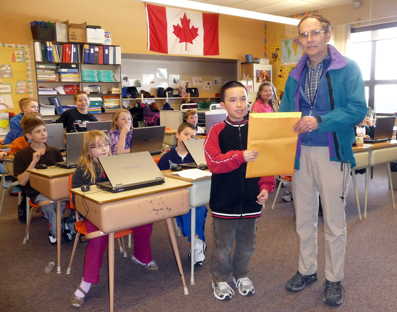
|
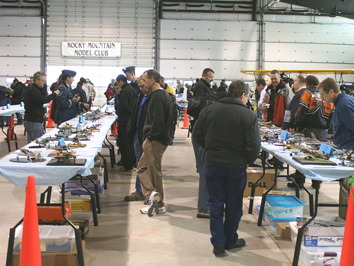 |
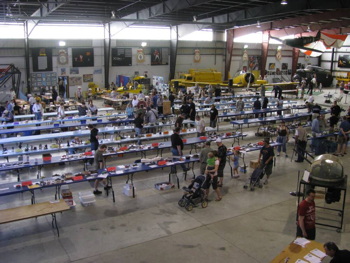 |
|
Together with other aviation museums across Canada, high school students in Nanton were introduced to careers in aviation as part of a February 7, National Aviation Day program. Museum volunteers John Phillips and Karl Kjarsgaard have both enjoyed many decades in the aviation business and told students of the challenges and rewards of careers as pilots and aircraft maintenance engineers.
L to R: Dave Birrell, J.T. Faster School principal Peter Weeks, Karl Kjarsgaard, and John Phillips in main hangar of the Bomber Command Museum on March 7 after meeting with students. |
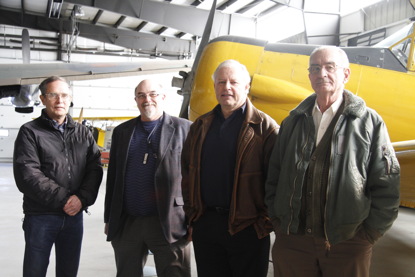 |
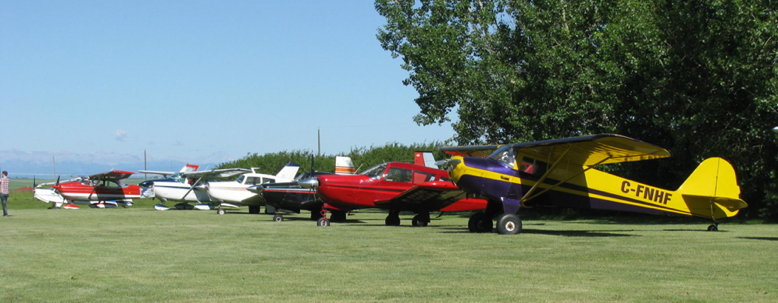
|
The idea of having an annual fly-in was originally proposed by Nanton resident and ex-Lancaster pilot, Joe English. Joe was a long-time Nanton Lancaster Society board member and supporter of the museum. With his passing away in 2010, it was decided that subsequent fly-ins should be a memorial to him. A large contingent of Joe English's family attended the first memorial Fly-In last July. We understand that members of the family will be attending again this year. Hot air balloons were off early at the AJ Flying Ranch airfield last year, making a spectacular beginning to the day that saw some 60 aircraft attend. ==> |
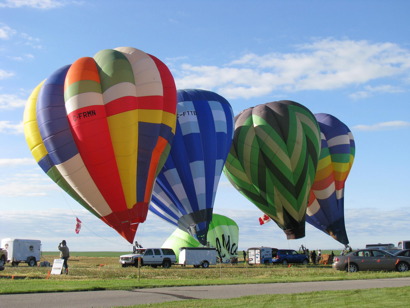
|
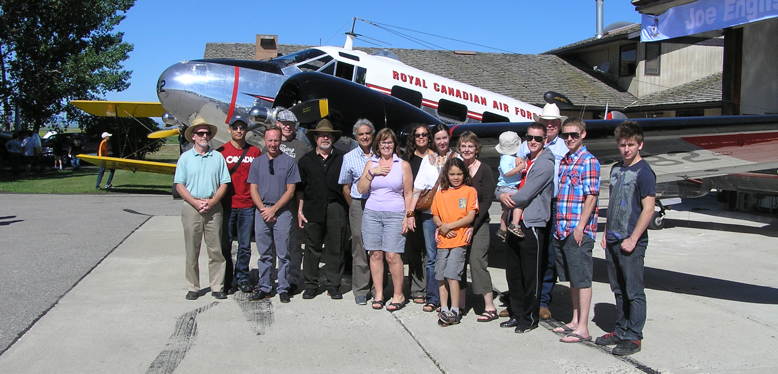
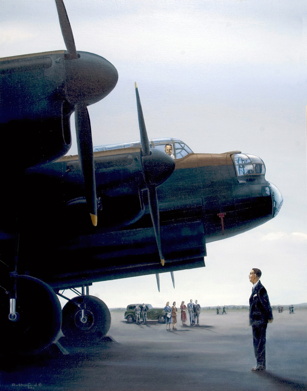
|
On May 8, 2011, the museum will commemorate Victory-in-Europe Day. We will also be marking the first flight of the Avro Lancaster seventy years ago. Don Hudson, our Honourary President and the nephew of Lancaster designer Roy Chadwick, will be in the cockpit for an engine-run to celebrate the occasion. Special tours through the cockpit of the Lancaster will be available during the day. Engine start-ups will be at 11:00 and 2:30. Also, there will be a special presentation made to the son of an early Alberta pilot, "Wop" May. (See next article) |
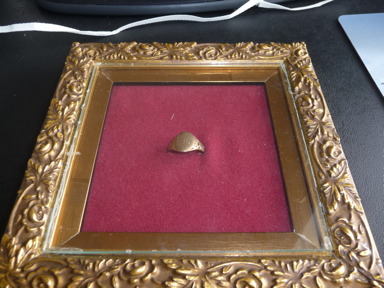 |
A long-forgotten ring and note were recently unearthed from the bottom of a filing cabinet in the museum's library. It was accompanied with a note from the late Joe English to whom it had been given to present to the museum. The ring belonged to pioneer bush pilot and WWI airman, "Wop" May, who was one of the pilots involved in the shooting down of the famous German air ace Richtofen. Upon finding this ring, Wop's son, Denny May, was contacted regarding the authenticity of the ring.. He said he has no reason to doubt it is authentic and has indicated that he'd like to have it as part of the family's collection. Denny May will be attending the May 8 event where his father's ring will be officially returned to him and his family. A piece of history indeed! |

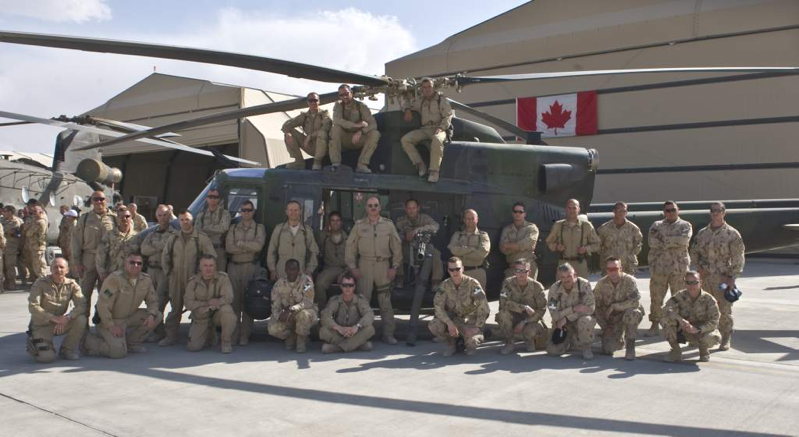
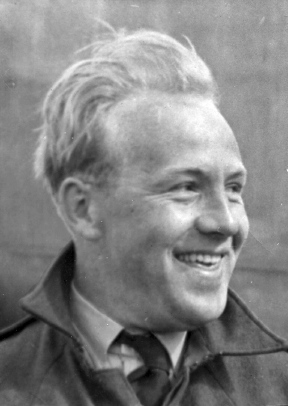
|
The Bomber Command Museum of Canada has taken the lead in honouring the thirty RCAF airmen who participated in the Dams Raid and the fifteen who did not return. Although an American, "Big Joe" McCarthy was one of these RCAF airmen. After receiving his wings in Canada, Joe completed an operational tour with No. 97 Squadron prior to being selected by Guy Gibson to join No. 617 Squadron. Following the Dams Raid, Joe continued with the Dambusters Squadron for another fourteen months, becoming a Flight Commander under Leonard Cheshire and participating in a remarkable series of varied and challenging operations. Following the war, Joe played a leading role in locating examples of Luftwaffe aircraft, ferrying them to England, and evaluating them. He then returned to Canada to complete a very full post-war career with Canada's Air Force. The museum is pleased to be working with Joe's family to document this outstanding RCAF airman's career. It is expected that the book, written by Dave Birrell, will be published in early 2012. If you have any information or photos regarding Joe, please let us know. |
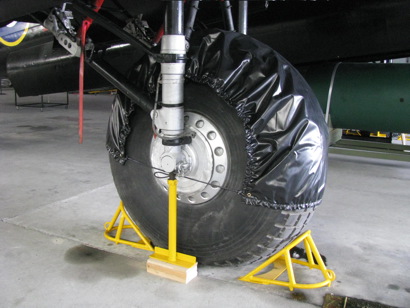 New oil resistant tyre covers have been made for the Lancaster's main gear. |
Over the past few months the Bow Valley College Sewing and Upholstery Program located at the Calgary Correctional Centre (CCC), has had the honour and privilege of repairing and remaking many items from the museum's collection. This has included seats from the Lancaster, Blenheim bomber and the Snowbird Tutor Jet, covers for the Lanc's main tyres, and reupholstering many of the museum's chairs. All these projects are being completed by inmates from the Calgary Correctional Centre. Over the years the Sew Shop has produced many different items for such organizations as the Royal Canadian Legion. Calgary Drop In Centre, Heritage Park and many other city, provincial, and federal groups and charities. I believe the excellent work the inmates do, gives them a sense of accomplishment that some have never had before. I and the Sewing and Upholstery Shop inmates look forward to a continued partnership with the Bomber Command Museum of Canada. |
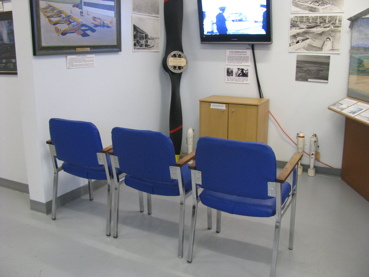 Here are three chairs that were reupholstered by inmates of the Bow Valley College Sewing and Upholstery Program, located at the Calgary Correctional Centre. |
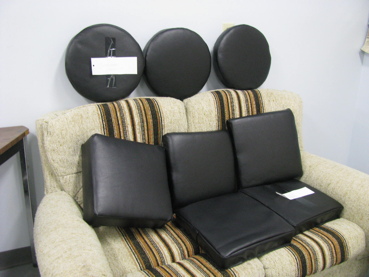 Seat cushions and backs have been restored by the CCC inmates. The cushions are for seats in the Lancaster, Blenheim, and Snowbird Tutor. |
Your museum has finally come up with a P&W 1340 engine locally from a crashed spray plane. This engine was purchased from aerial applicator Wayne Steir. Also we have had a disassembled 1340 engine donated by the Western Canada Aviation Museum (WCAM) in Winnipeg. Between the two engines we hope to create a run-able engine for the museum Harvard. It will likely be a couple of years before this engine is completed and installed, but you can look forward to hearing the "roar of a Harvard" when it is started up at a future museum event. We extend a grateful THANKS to Wayne Steir for his help and to the WCAM for the donation of the disassembled engine. This Pratt & Whitney 1340 engine from a crashed spray plane, was purchased from Wayne Steir for a very nominal fee. |
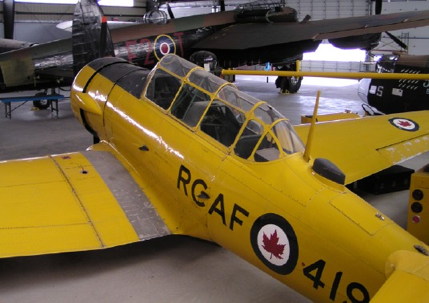 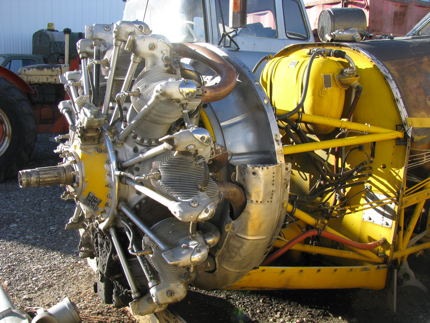
|
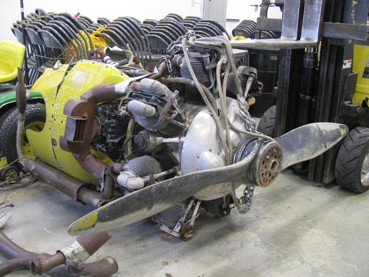
|
The museum's Airspeed Oxford project is at the moment only a collection of parts and no restoration has taken place to date. It is a project for the future. However, we continue to acquire parts that will be needed when it does get underway. The most recent addition to the stockpiled Oxford parts is the Armstrong Siddeley Cheetah engine, complete with a metal propeller as shown in the photo at left. |
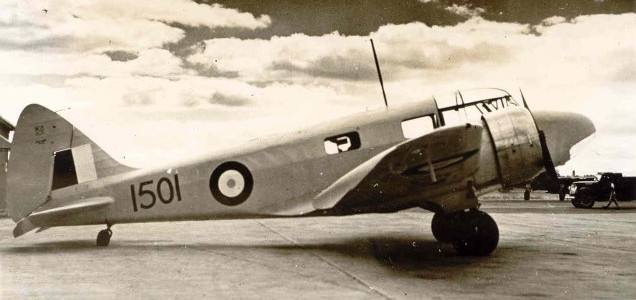
|
This will free up space in the main hangar where we will be placing our existing Halifax related artifacts, artwork, and information. As well, some of the Halifax components recently acquired in Europe will be arriving. These will greatly enhance the display and provide solid evidence of the museum's lofty ambitions to eventually have a restored Halifax on display together with our Lancaster. As well, visitors will notice a number of new signage panels in various sections of the museum. New to the museum is this VCR display with a mounted 40 inch flat screen TV. A short video of te Lancaster's Merlin engines being run-up is run daily in the museum. The video film was created by the Society's Ottawa member, Jim Blondeau. ==> |
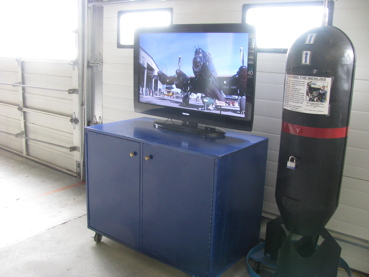
|
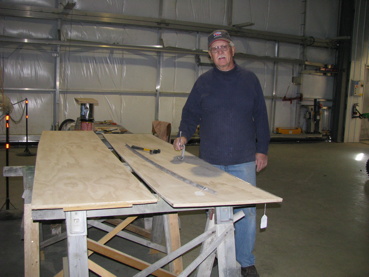 Wayne Bailey in the process of making new floor boards for the Beech Expeditor. |
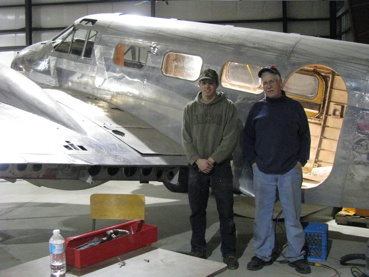 The Beech Crew. Ken Commings, (left) and Wayne Bailey stand beside the Expeditor. |
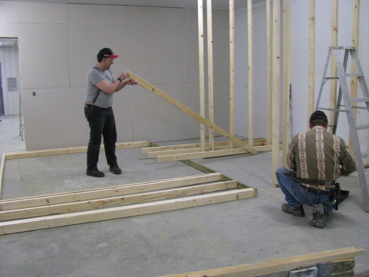
|
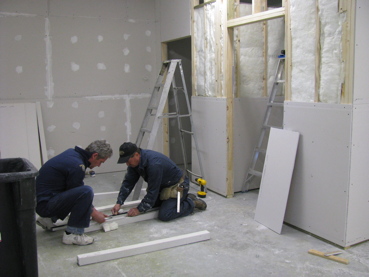
|
The months of November and December of 2010 saw some great progress towards the completion of the aircraft to an airworthy condition. Earlier in the year Neil Davidson of Kimberly, B.C., had completed the superb woodwork. The fuselage was prepared for the wings to be installed for the first time since the early 1980s. The fuselage wing fittings first had to be bolted to the fuselage permanently. The upper center section (containing the fuel tank) had to be properly rigged first before the wings could be installed. All four wings were then offered to the fuselage. As it turned out the wings had to be installed and removed several times to allow for sanding of some wood to allow clearance. |
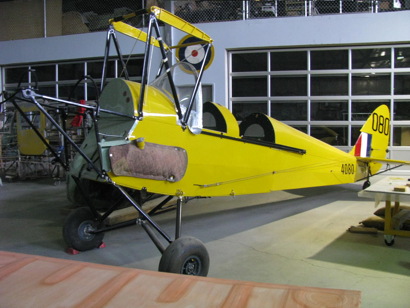
|
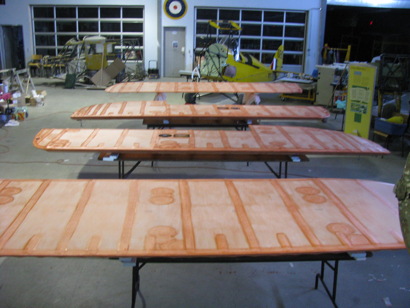 The Tiger wings are covered and await the final coats of paint. |
The fabric used is a Dacron polyester called Poly Fibre. The fabric is glued onto the leading and trailing edges as well as the tip and butt rib. Once the fabric is installed, it is shrunk with an seamstress iron, set at a specific temperature to shrink the fabric to its correct tightness. With all the wings covered, the first coats of a special product was applied to the fabric. Once this was dry the rib lacing positions laid out and all the holes poked through at a specific spacing. It took an entire week to rib lace all the wings. A cord being looped around each rib every 2-1/2 inches and secured with a special knot, all added up. About a 1000 knots were needed to complete all wings. With the ribs laced, they were then covered with finishing tapes and the inspection holes and reinforcement rings were then applied. |
|
Since the last newsletter, we have started to re-assemble the port inner engine. All of the engine components were cleaned and inspected as necessary. This engine had over 600 hours on it and had heavy carbon residue. We replaced the upper compression ring on each cylinder and replaced all of the seals on the coolant transfer tubes on both heads. The next phase involved installing the banks and heads and torquing them to spec. Merrill and Fred set the valve/tappet clearances and with help from John Phillips re-timed the cams to the crank shaft. I installed the intake manifolds and the high pressure priming lines. We will soon be moving the engine from the rotating engine stand to the engine bearer frame in preparation for adding the radiator water pump, thermostat and other accessories. |
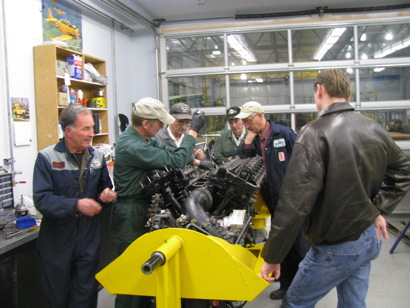 of reassembling the Lanc's, in-board Port Merlin engine. |
The photo at right is the artist's conception of a BOMBER COMMAND MEMORIAL, the ultimate international memorial to our aircrews who flew and died for our FREEDOM in bombers that will be built this year in Green Park, London, England, and dedicated in 2012. See the nine foot high statues in bronze of the seven men, a full bomber crew in combat gear! Now look to the right of the crew on top of the wall and see a word which should mean something to my fellow citizens and it is a name of a great country which starts with a "C". Now look down to the inscription below and see the word "VICTORY," which some of you may recall Canada had something to do with, which cost us 10,000+ young Canadian aircrew of the total 55,000+ aircrews of RAF Bomber Command. |
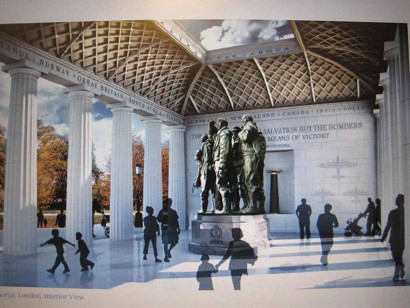
|
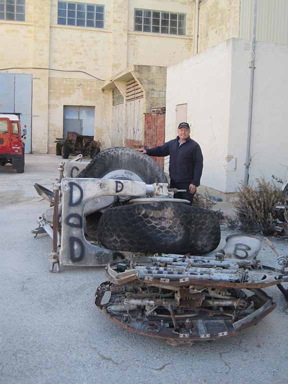
|
Now look below this and you will see the carvings of the bombers on the wall and one of these is a Halifax, one of the most important combat aircraft in all 101 years of Canadian powered flight and military history! And finally, look up to the ceiling of this stunning memorial-to-be and see the "aluminium" covering of the ceiling behind the geodetic ribbing and know this. The ceiling will be made from melted down ingots of a bomber of the Royal Canadian Air Force - Halifax LW682. In there will be the actual essence of the entire bomber crew who perished when this bomber went down in Belgium in 1944. And why would I show you all of this, which will become a reality in 2011-2012? Why would I send this in a Progress Report? Why would I, after the Bomber Command Museum of Canada and Halifax 57 Rescue (Canada) have unanimously agreed to support this UK memorial with these precious Halifax LW682 ingots and our efforts, why would I pass this on to you our international readership and supporters? Karl Kjarsgaard stands behind the Hastings/Halifax landing gear and firewalls, on site somewhere in Europe. These items are being made ready for shipping in a 40 foot container. Some of the contents should be arriving in Nanton later this spring. |
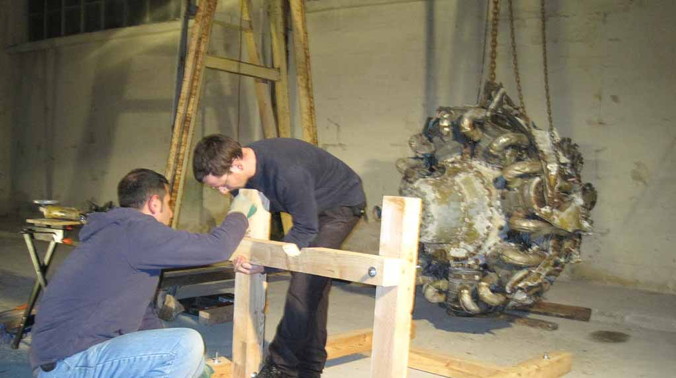
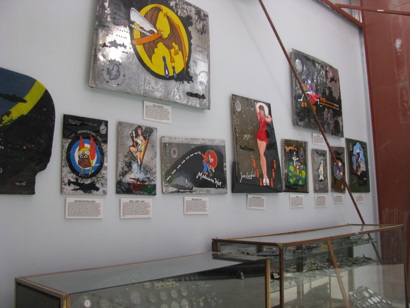 |
In 2008 and with the cooperation of Clarence Simonsen and others, the museum began the creation of a database of information and photographs of RCAF, RAF, RNZAF, and RAAF nose art. The archive now contains over 1800 photos of nose art and information related to more than 1100 different nose art images. The database is a "work in progress" that will eventually be shared with other museums and researchers, perhaps through the Internet in some manner. We regularly receive and welcome questions regarding the collection and specific nose art images. If you have photos of nose art and/or related information that you would like to contribute to the collection please let us know. |
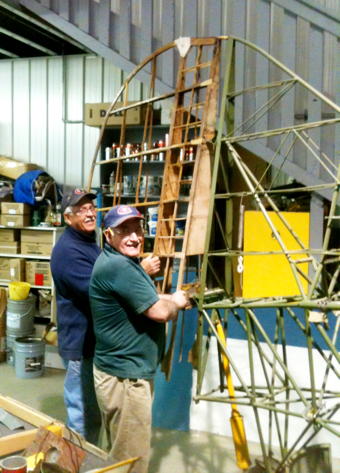 trial fit the Anson rudder that John has been restoring. (80% of the original wood used.) |
As the winter snow begins to recede it is time to take a look at the progress on old Annie. Dropping into the work shop, one will quickly see that this winter has been a very long one for Annie indeed. Bernie Janzen and Lloyd Lintott have been working away at completing the cockpit. Rudder pedals, control column, pilot and co-pilot seats, along with the fuel and hydraulic systems, are all ready to be reinstalled. In the wood shop John Maze has nearly completed reassembling the rudder. A few final pieces are left to go together and the rudder will be ready for skinning. It is a wonderful piece that when finished will be nearly 80% original. John has painstakingly preserved much of the original rudder, even after mice had tried their best to turn it into a mouse condominium. Work on the fuselage includes the restoration of the upper cabin hatch, construction of the fuselage formers just aft of the crew door and construction of the port aft window. Carl Orde, has diligently rescued what was left of the original hatch and has skillfully reconstructed the missing pieces. The discovery of two original formers has given us the basis to fabricate the much needed formers which are to be located just aft of the crew door. Doug Bowman has taken on this task. This is the last step before the Aft stringers can be applied to the fuselage. The Port aft window is shaping up very nicely thanks to the efforts of Charles Logie. Again like so many components, all we had to start with was a few original pieces and a few lines drawn on paper. Charles has made great progress in creating these parts that no longer exist. Yours truly has begun the restoration of the tail plane. The main and secondary spars were constructed for us several years ago by a member of our Society, Ron Jackson, when he also made spars for the Calgary Aero Space Museum's Anson project. They are now on the work bench unwrapped and ready to be finished. While the spars still need all the internal "guts" and the ribs need to be made up, the spars are a great boost to our project. Next time you're in Nanton make sure to drop and say "Hi" to old "Annie." |
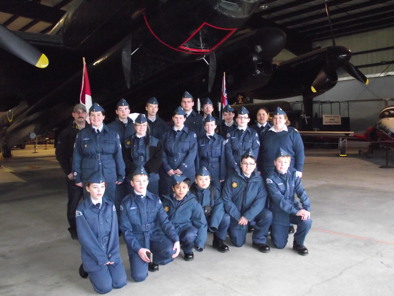 Membersof 624 Tisdale (Saskatchewan) and 745 Porcupine (Lethbridge) Air Cadet Squadrons visited the museum on February 22, 2011. |
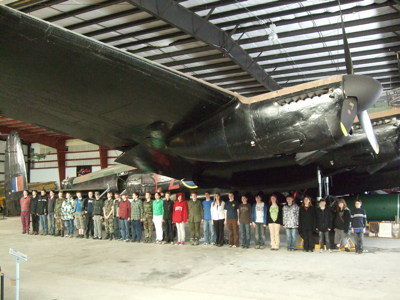 Twenty nine cadets from B.C. turned out on April 15 & 16 to help clean and prepare the museum for the spring/summer tourist season. The 279 Elk Valley squadron has been helping for a nomber of years and the 552 Key City Cranbrook joined them for the second time. The Bomber Command Museum extends a grateful thanks to all for their help. |
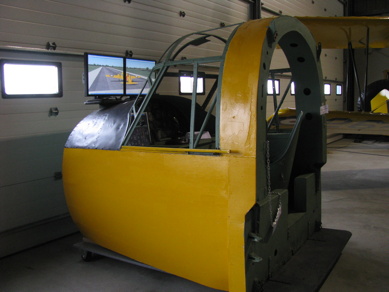 The Mk.V Anson cabin section Flight Simulator is back in operation having been upgraded with a 32 inch TV instead of the two 18 inch monitors. |
 The Cessna Crane forward fuselage is being converted and restored for use as the body of a second flight simulator for the museum. |